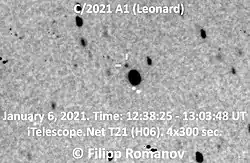C/2021 A1 (Leonard)
C/2021 A1 (Leonard),中文譯為雷納德[4]、倫納德[5]或萊納德[6],是一顆回歸的長週期彗星[7],於2021年1月3日由亞利桑那大學研究專員G.J.雷納德(G. J. Leonard)透過萊蒙山天文台發現,當時這顆彗星距離太陽5 AU(750 × 106 km),並且還需一年才會抵達近日點[1]。5AU是木星軌道與太陽的平均距離,這個距離也是甲醇(CH3OH)和水開始昇華(相變)的距離[8]。這是2021年發現的第一顆彗星,其軌道為逆行運動。在2021年12月12日,這顆彗星將以0.233 AU(34.9 × 106 km)的距離掠過地球,12月18日以0.028 AU(4.2 × 106 km)的距離掠過金星[3]。他將於2022年1月3日最接近太陽,並且預期在2021年12月可以在無光害的場所用裸眼看見這顆彗星[9]。彗星的視星等達到4等時,應該是雙筒望遠鏡觀賞的好目標。在通過近日點之後,這顆彗星將遠離或離開太陽系。

C/2021 A1繞行太陽的軌道動畫-2021年近日點
C/2021 A1 · 太陽 · 水星 · 金星 · 地球 · 火星
C/2021 A1 · 太陽 · 水星 · 金星 · 地球 · 火星
_(51710827445).jpg.webp) 2021年11月28日於英國貝福德伯里天文台拍攝的C/2021 A1彗星(39分鐘的堆疊圖像) | |
| 發現 | |
|---|---|
| 發現者 | G. J. 雷納德(G. J. Leonard) |
| 發現日 | 2021年1月3日[1] |
| 臨時編號 | C4AGJ62 |
| 軌道特性考 | |
| 觀測弧長 | 273 days |
| 遠日點 | ≈3500 AU(1950質心曆元)[2] |
| 近日點 | 0.615 AU |
| 離心率 | 0.9996(1950質心曆元)[2] 1.000017(2100質心曆元) |
| 週期 | ≈70000 yr (回歸的)[2] |
| 軌道傾角 | 132.68° |
| 與地球軌道相交 最小距離 | 0.2306 AU(34.50 × 106 km)[3] |
| 與木星軌道相交 最小距離 | 0.2972 AU(44.46 × 106 km) |
| 彗星整體星等 (M1) | 5.3 |
| 下次近日點 日期 | 2022年1月3日 (followed by ejection) |

C/2021 A1彗星的長曝光複合圖像
使用這顆彗星進入太陽系行星區域之前的1950年曆元,以質心軌道解析的軌道週期約為7萬年[2]。因此,這顆彗星大約在35,000年前,在距離3,500 AU(520 × 109 km)處開始回歸。在2022年9月之後,以雙曲線軌道向太陽系外移動[2]。
參考資料
- . minorplanetcenter.net. [2021-01-10]. (原始内容存档于2021-01-10).
- Horizons output. . [2021-01-13]. (Solution using the Solar System's barycenter (Sun+Jupiter). Select Ephemeris Type:Elements and Center:@0) Epoch 1950 has PR= 2.64E+07 / 365.25 = 72000 years
- . JPL Small-Body Database Browser. [2021-01-10]. (原始内容存档于2021-02-15).
- 陳昱婷; 葉臻. 李錫璋 , 编. . 台北. 中央通訊社. 2021-12-11 [2021-12-11]. (原始内容存档于2021-12-22) (中文(繁體)).
- Chloe. . 明日科學. 2021-09-01 [2021-11-27]. (原始内容存档于2021-11-27) (中文(繁體)).
去年12月18日發現的彗星C/2021 A1(倫納德)......
- vivian (编). . cnBeta. 2021-02-05 [2021-11-27] (中文(简体)).
并将其命名为“莱纳德”(Leonard,正式名称为 C/2021 A1)......
- CBET 4907: original 1/a = +0.000575 (long-period) and future 1/a = -0.000030 (hyperbolic). The orbital energy is inversely proportional to negative semi-major axis. Objects in hyperbolic orbits have negative semi major axis, giving them a positive orbital energy.
- . [2021-01-23]. (原始内容存档于2021-01-28).
- Magnitude estimate (页面存档备份,存于) – Seiichi Yoshida
| 维基共享资源上的相关多媒体资源:C/2021 A1 |
This article is issued from Wikipedia. The text is licensed under Creative Commons - Attribution - Sharealike. Additional terms may apply for the media files.